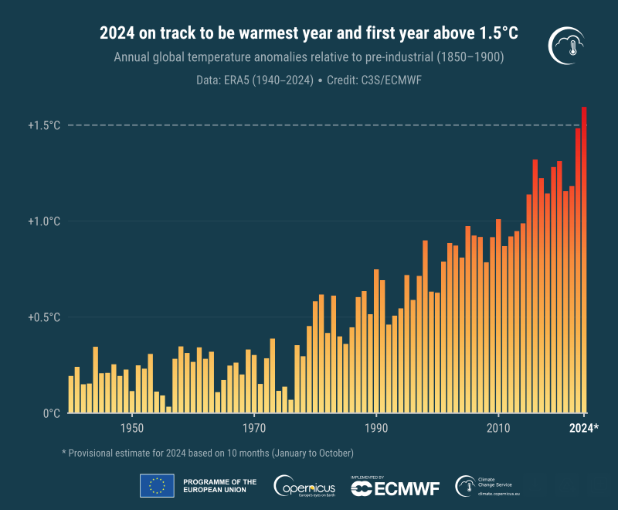The European Center says 2024 is “certain” to be the warmest year on record

Climate scientists working in the European Union's Copernicus Climate Change Service they announced that 2024 is “certain” to be the warmest year on record.
According to its ERA5 data, the agency said it is “certain” that the annual temperature by 2024 will be more than 1.5 degrees Celsius above pre-industrial levels, and is likely to be more than 1.55 C higher.
For decades, scientists have warned that the average global temperature should not be more than 1.5 C above pre-industrial times to prevent deadly weather conditions that could affect people around the world.
The world is already too warm and has seen the results with back-to-back heat waves, droughts and unprecedented floods and storms. The way farmers grow food has already begun to change, too 1.5 to 2 degrees Celsius of warmingagricultural yields will decline and sea levels could rise to 10 meters, the researchers found. Experts say the oceans will also warm, fueling stronger storms and threatening ecosystems that are important to the economy and help protect areas from extreme weather.
Copernicus Climate Change Service /ECMWF
“This marks a new milestone in global temperature records and should be a catalyst for raising the profile of the upcoming Climate Change Conference, COP29,” said Samantha Burgess, deputy director of the Copernicus Climate Change Service, in a statement.
The Copernicus Climate Change Service said the average global temperature for the first 10 months of 2024 (January to October) is 0.71 C above the 1991-2020 average, the highest average for this period and 0.16 C warmer than the same period. in 2023.
“The average temperature for the whole year 2024 will have to drop to zero in 2024 in order not to be the warmest year,” the agency said.
The agency added that since 2023 was 1.48 °C above pre-industrial levels according to its ERA5 model, it is also possible that the annual temperature of 2024 will be more than 1.55 °C higher.
Europe's temperatures were above average for almost the entire continent, Copernicus found. Outside of Europe, temperatures were above average over Northern Canada, and above average over the midwestern United States, northern Tibet, Japan and Australia.
Copernicus Climate Change Service /ECMWF
The agency also said Arctic sea ice reached its fourth lowest monthly extent in October, 19% below average. Sea ice extent is a measure of the area of the ocean covered by ice.
Sea ice problems were below average in all seas near the Arctic Ocean, especially in the Barents Sea, the Canadian Archipelago, and north of Svalbard, the agency said.
Antarctic sea ice extent was 8% below average in October, which was the second lowest such average after only October 2023, when it was 11% below average, Copernicus said. Those numbers continued “a series of major negative issues seen in 2023 and 2024.”
The Copernicus Climate Change Service, funded by the EU, regularly publishes monthly reports on observed changes in global air and sea temperatures, sea ice coverage and hydrological variables. All reported findings are based on computer-generated analysis and the ERA5 data set, which uses billions of measurements from satellites, ships, aircraft and weather stations around the world.
In a report published last month, the United Nations warned that the world is now in “extreme climate change” as greenhouse gases in the atmosphere warm global temperatures and exacerbate extreme weather events – they are here “unprecedented levels.”
“The numbers paint a clear picture,” the UN said. “To keep emissions below the critical 1.5-degree target set in Paris in 2015, countries must reduce emissions by 42 percent by 2030 and achieve a 57 percent reduction by 2035.”
Source link





